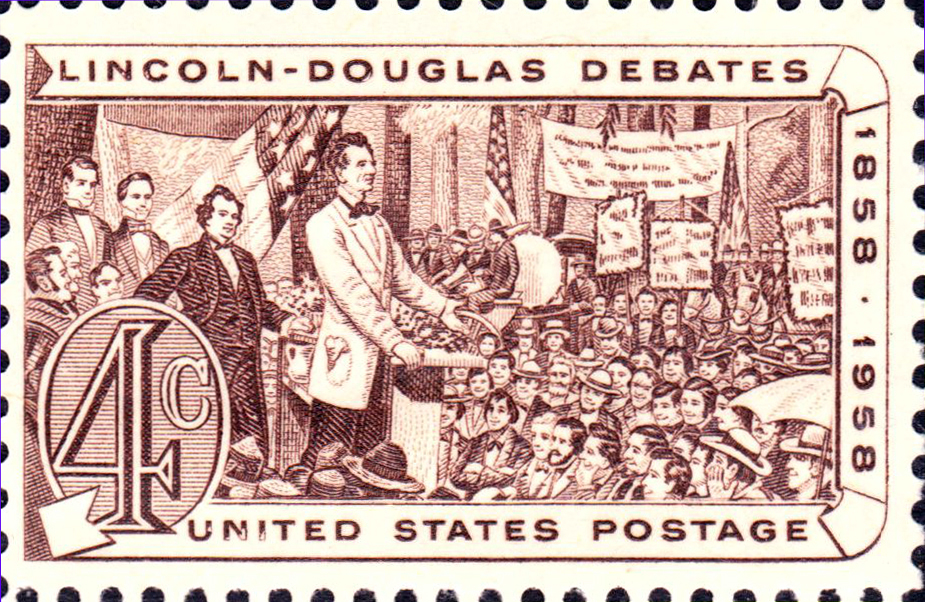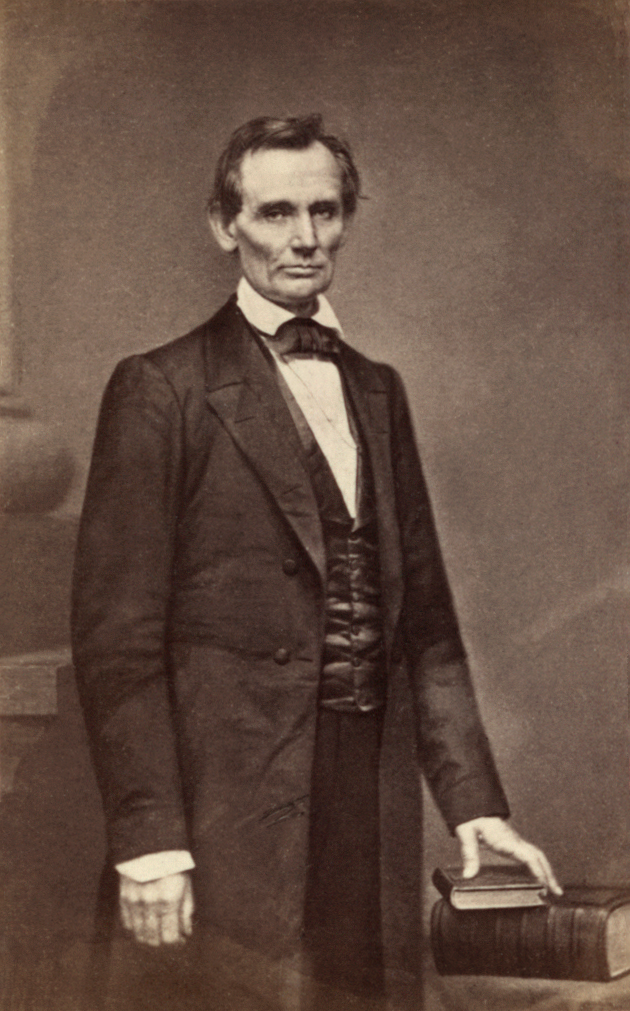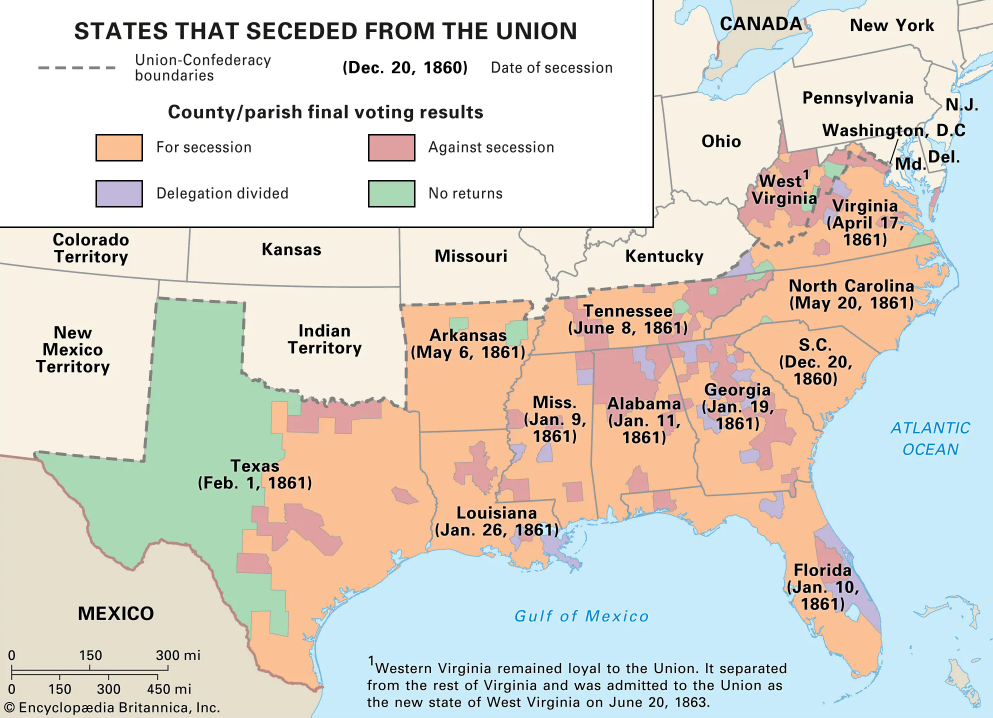Dalia Savy
AP US History 🇺🇸
454 resourcesSee Units
As the Election of 1860 approached, it became clear that the country was more deeply divided than ever over the issue of slavery in the territories. The four main candidates in 1860 campaigned on different solutions to that issue and the American vote split.
Lincoln-Douglas Debates
Prominent Democratic senator from Illinois, Stephen Douglas, faced a tough re-election battle in 1858 against newcomer and Republican Abraham Lincoln. The nation watched the election for the Senate seat closely, as the debates brought in crowds as big as 12,000 people to hear them discuss the issues of slavery, popular sovereignty, and the expansion of the United States.

Image Courtesy of Wikipedia
Lincoln was not an abolitionist. As a moderate who was against the expansion of slavery, he spoke effectively of slavery as a moral issue. He argued that the nation had reached the crisis point in the struggle between slavery and freedom stating the following:
“A house divided against itself cannot stand.” I believe this government cannot endure, permanently half slave and half free. I do not expect the Union to be dissolved—I do not expect the house to fall—but I do expect it will cease to be divided. It will become all one thing, or all the other. - Abraham Lincoln
Southerners heard this and viewed Lincoln as a radical. Lincoln continued to go with the theme that Douglas was a covert defender of slavery because he was not a principled opponent of it. Douglas responded in what became known as the Freeport Doctrine, where slavery could not exist in a community if the local citizens did not pass laws (slave codes) maintaining it. Basically, a territory could exclude slavery simply by not adopting laws that protect it.
Despite these intense debates, Douglas won the U.S. Senate seat in 1858. Lincoln's performance, however, made him a national figure and a future star for the Republican Party.

Image Courtesy of the Lincoln Memorial Shrine
The Election of 1860
The election was held during a period of great tension and division in the country, with the issue of slavery being a major point of contention. There were four candidates running at the time:
- The Republican Party, led by Lincoln, ran on a platform that opposed the expansion of slavery into the territories and advocated for the preservation of the Union. He basically called for slavery to stand only where it currently existed.
- The Democratic Party, which was split into Northern and Southern factions, nominated Stephen Douglas as their candidate. He opposed a federal slave code and supported popular sovereignty.
- The Southern Democrats, led by John C. Breckinridge, ran on a platform that supported the expansion of slavery and the rights of individual states to decide the issue for themselves.
- The Constitutional Union Party, led by John Bell, ran on a platform of preserving the Union and avoiding the issue of slavery to keep the country united.
Coming into this election, Lincoln was already pretty much known. He was first a Congressman from Illinois in the 1840s, gained nationwide fame for his opposition to the Mexican-American War, and later was understood for his 1858 debates with Stephen Douglas for a U.S. Senate seat for Illinois. While holding ideas that were racist by modern standards, he was known for personally opposing the practice of slavery and politically opposing its spread westward.
Abraham Lincoln: The Winner
On November 6, 1860, Lincoln won the presidential election with 180 electoral votes, while Douglas received 12, Breckinridge 72, and Bell 39. Lincoln only won 40% of the popular vote in the election, but he won in a majority of the Northern states, which gave him the electoral votes needed to secure the presidency.

Image Courtesy of Wikimedia
Because Lincoln, as a Republican, was determined to stop the spread of slavery out west, the South reacted with horror. They feared Lincoln’s leadership would stop the spread of slavery, embolden abolitionists in the North, and possibly even attack slavery in the Southern states.
The election of 1860 demonstrated the South’s political weakness because a Northern Republican could win the presidency without a single electoral vote from the South.
In an effort to stop the impending secession of some Southern states, some lawmakers proposed the Crittenden Compromise. The compromise proposed to extend the Missouri Compromise line (36° 30' parallel) westward and northward to California. It would have made slavery illegal in territories North of the line and would have allowed it in territories South of the line. It would have also proposed a constitutional amendment to guarantee the rights of slaveholders and would have protected the Fugitive Slave Act of 1850, which required citizens to assist in the capture of runaway slaves.
The compromise failed to gain enough support from either side and was never passed by Congress.
- Many Northern politicians opposed the compromise because it would have effectively legalized slavery in the territories South of the Missouri Compromise line and because it would have protected the Fugitive Slave Act.
- Many Southern politicians rejected the compromise because it would have made slavery illegal in the territories North of the Missouri Compromise line and because it did not go far enough in protecting the rights of slaveholders.
Secession
In response to the Election of 1860 and the fear of the abolition of slavery, several southern states began to secede. South Carolina was the first state to secede from the Union in December of 1860, but the Deep South soon followed after. This response was fast, as Lincoln hasn't even been inaugurated (March 1861). Imagine how much tension there was.

Image Courtesy of Britannica
These cotton-growing states created the Confederacy on the basis of White Supremacy and against the fear that Lincoln would interfere with their slaves either out West or even down South (see the states’ secession declarations). Jefferson David was the President of the Confederate States of America.
The Start of the Civil War
Lincoln waited for the South to make the first move, and eventually, in April 1861, the rebels attacked the Federal arsenal at Ft. Sumter in South Carolina. They attempted to force the Union garrison stationed there to surrender.
The attack on Fort Sumter was a major catalyst for the outbreak of the Civil War, as it rallied Northern public opinion behind the Union cause and led to the call-up of 75,000 volunteers to put down the rebellion. The call for volunteers caused the Upper South to secede as well because they opposed the use of violence to force fellow Southern states back to the Union.
Remember that Fort Sumter was the site of the first shots of the American Civil War.
Browse Study Guides By Unit
🌽Unit 1 – Interactions North America, 1491-1607
🦃Unit 2 – Colonial Society, 1607-1754
🔫Unit 3 – Conflict & American Independence, 1754-1800
🐎Unit 4 – American Expansion, 1800-1848
💣Unit 5 – Civil War & Reconstruction, 1848-1877
🚂Unit 6 – Industrialization & the Gilded Age, 1865-1898
🌎Unit 7 – Conflict in the Early 20th Century, 1890-1945
🥶Unit 8 – The Postwar Period & Cold War, 1945-1980
📲Unit 9 – Entering Into the 21st Century, 1980-Present
📚Study Tools
🤔Exam Skills
👉🏼Subject Guides
📚AMSCO Notes

Fiveable
Resources
© 2025 Fiveable Inc. All rights reserved.